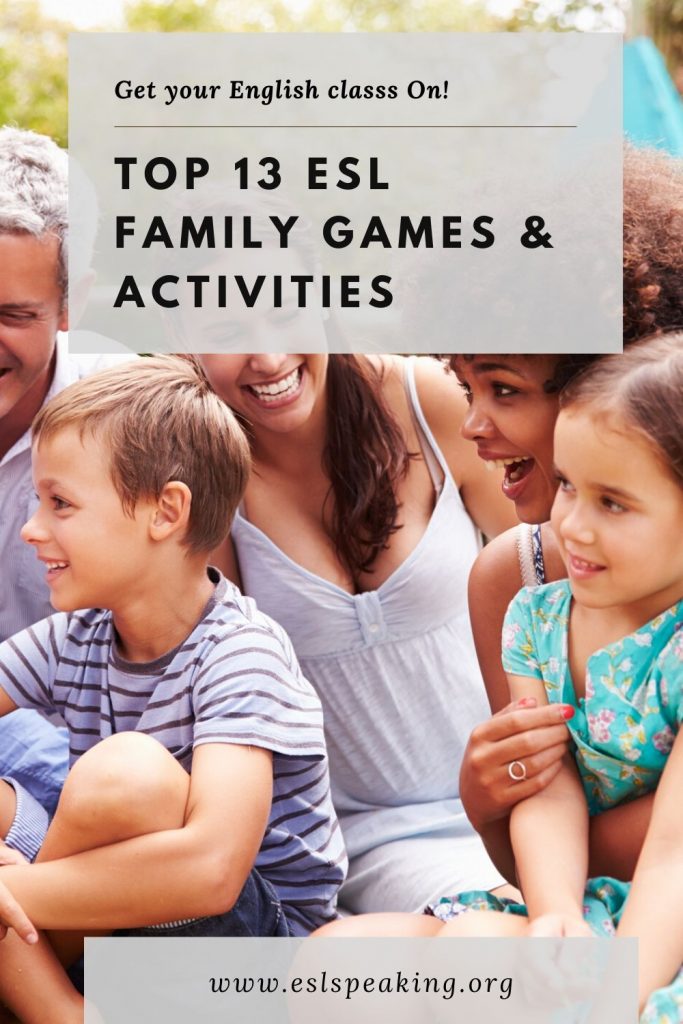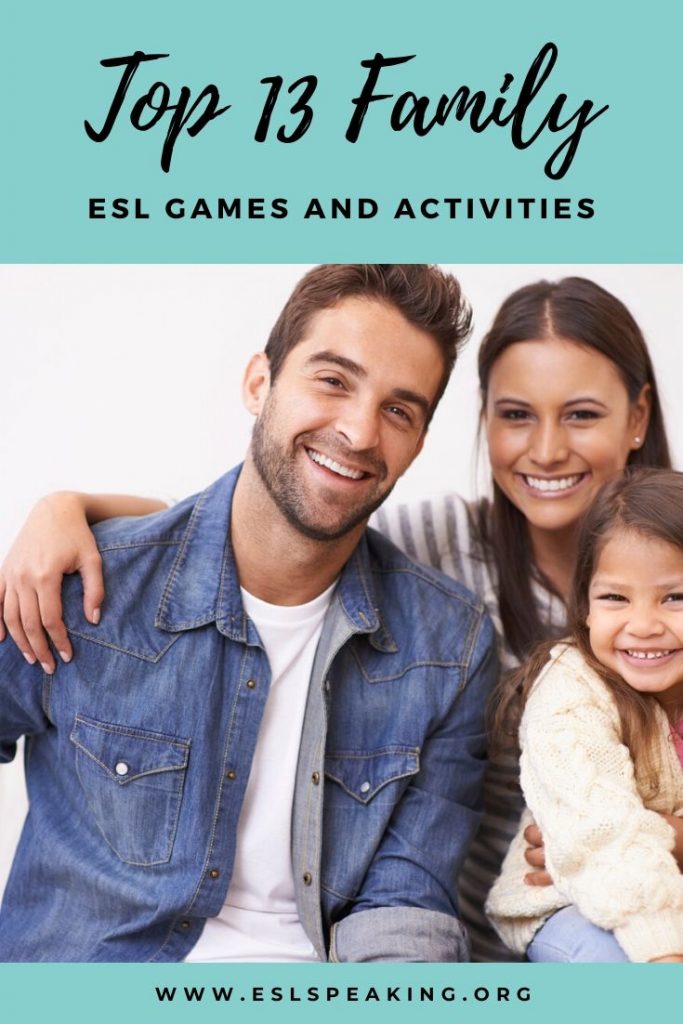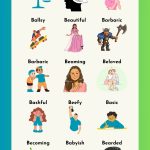If you’re looking for some of the best ESL family games, including family tree activities, then you’re certainly in the right place. We have the top 15 for you to consider, along with family ESL worksheets, lesson plans, vocabulary lists and more.
ESL Family Games and Activities
Are you ready? Let’s get to the ESL family activities!
#1: ESL Family Tree Activity
A classic ESL activity for this unit is get students to make a family tree. Many textbooks will have this kind of chart in them or you can print a simple one off the Internet. Finally, you could show some examples to your students and have them draw their own. It’s also a great homework or presentation idea.
The choice is yours, but try out a family tree activity for this unit and I’m sure you’ll love it as much as I do! The key to this is to get students to fill in the names of people, along with the words in English for who they are in relation to the student.
#2: Just a Minute ESL Family Speaking Activity
If you teach intermediate or advanced learners, then consider using Just a Minute in your classes. The way it works is that students have to talk about their families for 1 minute without stopping. The other people in their group need to listen carefully and think of at least 1 follow-up question they could ask.
Want to give it a try with your students? Check it out here: ESL Just a Minute Speaking Activity.
#3: Family Members Song for Kids
When teaching kids, songs and chants are one of the best ways to help them remember new vocabulary. Sometimes I’ll even catch my students singing these songs to themselves outside of class! When I hear this, I consider my job to be done!
The good news is that if you don’t have a musical bone in your body (like me), it’s still possible to use them in class. There are lots of nice options on YouTube.
#4: Chain Spelling ESL Family Game
A quick, easy game to review vocabulary and spelling is this one. The way it works is that students take turns spelling out vocabulary words letter by letter. In this case, you’d want to focus on family vocabulary, but it can be used for any topic. When they miss one, they’re “out” of the game and the last person standing is the winner.
Want to find out more? Check it out here: ESL Spelling Game.
#5: Dialogue Substitution
New vocabulary is often introduced through a dialogue of some kind in ESL textbooks. However, have you noticed that students often just blow through them quickly without really paying attention to what they’re reading? Of course, it’s not their fault! It’s just that we haven’t given them a reason to read carefully.
A way to combat this is to remove some of the key words. In this case, the family vocabulary, especially is students are familiar with many of them. Then, it adds a layer of meaning to the reading skills required. Learn more about this here:
ESL Dialogue Reading Activity.

ESL Family game
#6: ESL Speaking Family Lesson Plan
It’s very easy to design your own speaking lesson plans that are tailored exactly to the level and needs of your students. The easy part comes in if you follow a template of some kind! Here’s my top recommendation:
ESL Speaking Lesson Plan Template.
#7: Speaking Fluency Activity
#8: Family Conversation Starters
If you ask your students what they want to do in your class, many of them will say things like free talking, conversation or speaking. However, it can be a little bit difficult to just tell students to, “Talk about your family with a partner for 5 minutes,” and not be met with a lot of silence.
A far better way is to encourage students to talk freely, ask follow-up questions and go where the conversation leads but them also have a list of questions related to the topic in case they get stuck. Here are just a few family-related conversation starters:
- Tell me about your family.
- Who are your family members?
- Who do you spend the most time with in your family?
- Do you eat dinner together every night? Why or why not?
- How often do you visit with your grandparents?
- What does your family like to do together?
More ideas for conversation starters for various topics here: ESL Conversation Starters.
#9: ESL Family Listening Lesson
I love to include some dedicated listening practice into all of my classes because it’s often the case that general English classes focus a lot on speaking. However, listening is half of conversation so it really is important!
It’s easy to find listening passages for the topic of family in many ESL textbooks or have a look online. It should be easy to find one at an appropriate level for your students in just a couple of minutes. Then, use this template to design an entire lesson around it:
ESL Listening Lesson Plan Template.
#10: Word Association Warmer Activity
Unless students are beginners, it’s likely that they already know some family vocabulary. I like to help students activate this prior knowledge before adding new words into the mix. This activity is one of the best ways to do that:
#11: Family Tree Chart for English Learners
Maybe your students are kind of like mine. By this, I mean that I think that they get tired of hearing me talk by the end of the semester! In order to combat this, I sometimes like to show them videos explaining new vocabulary or grammar points from other teachers!
#12: Picture Prompt
It’s often the case that students already know a good amount of family vocabulary unless they are absolute beginners. If this is true for your students, consider using a warmer activity to help them activate this prior knowledge. It’ll make the new stuff “stick” more easily.
One such activity is picture prompt. It’s simple, but effective at generating lots of these family type vocabulary words. More details here:
#13: Running Dictation
This is a classic, 4-skills ESL activity that’s ideal for injecting a bit of fun and excitement into any class. The way it works is that students have to work together in pairs of piece together a dialogue related to family. Find out more about it right here:
#14: Family ESL Survey
Just ask my students and they’ll tell you that I love to use surveys in my classes! This is because they cover a wide range of skills and also that they get students out of their seats and moving around the classroom. Perfect for that Friday afternoon or Monday morning class, right?
Find out how make your own and see some of my example ESL questionnaires on a variety of topics here:
ESL Surveys and Questionnaires.

Family ESL Activity
#15: Famous Families
Choose a famous family that your students would be familiar with. Prepare a PowerPoint presentation with the highlights in case some students aren’t. For example, the Simpsons would be a good example.
Then, elicit some answers to questions like this:
- Bart is Lisa’s _____.
- Who is Homer’s son?
- Etc.
#16: Plan a Family ESL Conversation Lesson
It’s easier than you might think to design your own lesson plans for just about anything, including the family unit. Have a look here for the steps to follow:
#17: Describe your Family Members
A simple ESL family activity that’s ideal for this unit is to get students to describe their family members to each other. First, brainstorm some physical characteristics as well as personality traits so that students are familiar with some of the vocabulary required.
I generally require that student ask 1-2 follow-up questions about each person to their partner in order to make this activity a bit more interactive and to give students a reason to listen.
#18: Me Too!
This is a simple game that works well for beginners. Students have to make a true statement about themselves related to their families. For example:
- I have one brother.
- My grandparents live with me.
- I have a stepfather.
If the other students in the class can say yes to the statement as well, they can stand up and say, “Me too!”
#19: Fun ESL Games to Teach the Family Unit
#20: Family Flashcards
Create flashcards with pictures of family members. Students can use these cards for various activities like matching games, memory games, and describing relationships.
#21: Guess the Family Member
Describe a family member without revealing their name, and have students guess who it is based on the description. For example, “This person is the sister of your mother.”
#22: Family Bingo
Create bingo cards with family-related vocabulary words. Call out definitions or descriptions, and students mark the corresponding family member on their bingo cards.
#23: Family Interviews
Students interview their classmates about their families, asking questions like “How many siblings do you have?” and “Who is your favorite family member?”
#24: Family Role Play
Assign roles to students (mother, father, sister, etc.) and have them act out family scenes, like a family dinner or a celebration.
#25: Family Comparisons
Provide sentences with incomplete family descriptions (e.g., “My sister is taller than…”). Students complete the sentences by comparing family members’ characteristics.
#26: Negative Personality Traits
We all have that one family member who is hard to get along with! That’s what makes learning these negative character traits a natural fit for this unit!
Negative Personality Traits List.
ESL Family Vocabulary
- Aunt
- Brother
- Brother-in-law
- Children
- Cousin
- Dad
- Daughter
- Father
- Grandfather/grandpa
- Grandmother/grandma
- Husband
- Mom
- Mother
- Nephew
- Niece
- Parents
- Sister
- Sister-in-law
- Son
- Uncle
- Wife
Family ESL Worksheets
There are lots of useful ESL family worksheets online so there’s no need to make your own. Here are some of the best resources:
Family ESL Lesson Plans
One of the best ways to save a ton of time is to recycle lesson plans. In this case, there are lots of excellent ESL family lessons that you can just print off and use with your students. Here are some of our top picks:
Did you Like these ESL Family Games and Activities?
- Amazon Kindle Edition
- Smith, Jennifer Booker (Author)
- English (Publication Language)
- 134 Pages - 03/31/2016 (Publication Date)
Yes? Thought so. Then you’re going to love this book over on Amazon: 101 ESL Activities for Kids. The key to better English classes is a wide variety of interesting, engaging and student-centred activities and this book will certainly help you do that in style.
Keep a copy on the bookshelf in your teachers’ resource room to use as a handy reference guide. Or, take the book with you on your phone, tablet, or laptop to your favourite coffee shop for some serious lesson planning on the go. It really is that easy to have better TEFL classes for children.
Check out the book for yourself over on Amazon but only if you want to get yourself a serious dose of ESL teaching awesome in your life:
Have your Say about these ESL Family Games
What’s your top pick for a ESL family tree activity or game? Is it one of the options from this or do you have your eye on another one? Leave a comment below and let us know what you think. We’d love to hear from you.
Also be sure to give this article a share on Facebook, Pinterest, or Twitter. It’ll help other busy English teachers, like yourself find this useful resource.
Last update on 2024-04-25 / Affiliate links / Images from Amazon Product Advertising API






Leave a Reply